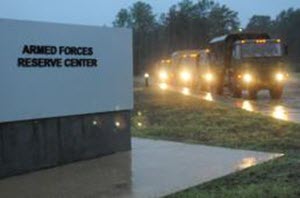Story by: Sgt. Michael Giles
Posted: October 25, 2015
 Sgt. Michael Giles
Sgt. Michael Giles
Members of the Texas National Guard's 236th Engineering Company stand ready within Light Medium Terrain Vehicles to engage in flood rescue operations in Huntsville, Texas, Oct. 25, 2015. Members of the 236th Engineering Company, part of the 111th Engineering Battalion, mobilized to Corsicana and Huntsville, Texas, to stand ready to respond to any rescue needs caused by the rainstorms resulting from Hurricane Patricia in October 2015. (U.S. Army National Guard photo by Sgt. Michael Giles/Released)
HUNTSVILLE, Texas —"Everybody here, myself included, is ready to do what we have to do," said Staff Sgt. Kevin L. Frawley, a squad leader in the National Guard's 236th Engineering Company. He traveled with his team from Lewisville, Texas, to Corsicana, and then to Huntsville, anticipating a need for flood rescue operations.
Spc. Steven R. Hankins, an engineer who helped rescue upward of 30 people during the storm of May 2015, has a lot of experience with these sorts of disaster missions. He said that they are equipped to rescue flood victims because of how their trucks are built. Their height and weight allows them to navigate in deep and flowing water, and they are airtight enough to almost entirely submerge for up to 15 minutes. They rescue people by driving toward the houses, vehicles, and even trees where they are stranded, and pull them on board.
"We pulled a man out of a tree after water had surrounded his car," Hankins said. "This man popped his trunk, climbed out the back and up a tree. Luckily, we could get to him."
This team of citizen-soldiers, led by 1st Lt. Clayton C. Harrison, consists of military-trained engineers, plumbers, and electricians, many of whom have participated in multiple flood rescue operations.
"Some people really get stuck in jams," said Sgt. Charlie W. Brown. "Sometimes we're the only people who can get to them. I love what I do."
The ability of the 236th to rescue also comes from their readiness to be where they need to be. These citizen-soldiers were called up on Oct. 23, 2015, and activated for days of swift water movements throughout central and east Texas. They traveled to Corsicana the following morning, where floodwater derailed a train and neighboring guardsmen rescued a reported 14 civilians from homes and vehicles.
"We're out here, we're ready and we're prepared," Harrison said. "The people of Texas are much safer because units like the 236th anticipate needs and prepare to respond."
Later that day, they drove in a convoy of six vehicles to Huntsville, Texas, where they stood by at the Armed Forces Reserve Center in case they were needed. The following morning, it was determined that the risk in Huntsville was low enough that it was safe to depart.
"We try to minimize risk, but there's always risk when dealing with mother nature," Harrison said. "In the end, it's a good thing we didn't have to go out today."